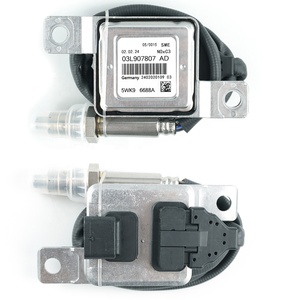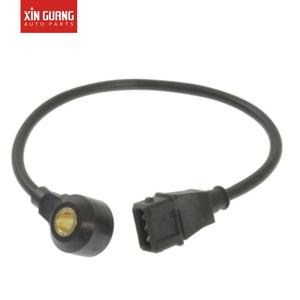(133 products available)








































































































































































An auto-knock sensor for Opel is a device used in vehicles to detect engine knocking or pinging. Knocking is a combustion problem caused by abnormal combustion of the air-fuel mixture in the engine's cylinders. It can cause serious damage to the engine if left undetected. The knock sensor detects this issue and signals the engine control unit (ECU) to adjust the engine parameters. This ensures optimal engine performance and prevents potential engine damage. Below are some types of Opel knock sensors:
1.1st Generation Opel Knock Sensor:
1st-generation Opel knock sensors are generally used in early knock sensor vehicles. They have a basic design and functionality, using a simple piezoelectric element to detect knock vibrations. The sensors have a metal housing and are mounted directly on the engine block or cylinder head. Their main work is to detect mechanical knock vibrations and send electrical signals to the ECU. The signals help the ECU adjust ignition timing or other parameters to prevent engine damage.
2.2nd Generation Opel Knock Sensor:
2nd-generation Opel knock sensors are used in more advanced knock sensor vehicles. The sensors have an improved design and sensitivity features. They have dual-element or integrated microcontroller designs. The sensors are mounted on the engine block, cylinder head, or intake manifold. Their work is to detect knock vibrations and analyze engine data simultaneously. They send more detailed signals to the ECU. The signals allow for more precise adjustments to ignition timing and other engine parameters. This optimizes engine performance and reduces emissions. The sensors also feature self-diagnostic capabilities. They can monitor their health and performance and alert the driver or service personnel in case of a fault.
3.3rd Generation Opel Knock Sensor:
The 3rd-generation Opel knock sensors are used in the latest knock sensor vehicles. They have advanced technology and high sensitivity features. The sensors have MEMS (Micro-Electro-Mechanical Systems) technology. This technology enables the sensors to have miniaturized and highly sensitive elements to detect even the slightest knock vibrations. The sensors are usually mounted on the engine block, cylinder head, or exhaust system. Their work is to detect knock vibrations, exhaust gas temperatures, and other engine parameters in real time. They send continuous and precise signals to the ECU. The signals allow for instant and accurate adjustments to ignition timing, fuel injection, and other engine parameters. This optimizes engine performance, maximizes fuel efficiency, and reduces emissions. The sensors also feature advanced algorithms, self-learning capabilities, and connectivity options. They can communicate with other control units or external devices, enabling advanced diagnostics, data analysis, and online updates.
Here are the general specifications of the auto knock sensor for Opel vehicles:
Operating Voltage
The knock sensor operates with a voltage of between 5 to 10 volts. The voltage is supplied by the vehicle's engine control unit (ECU).
Frequency
The knock sensor is designed to detect vibrations with frequencies ranging from 1 to 5 kHz. The frequencies are associated with engine knock occurrences.
Output Signal
Knock sensors send signals to the ECU, such as an increase in engine vibrations or knocks. The output signal from the sensor is within the range of 0 to 5 volts.
Sensor Type
Piezoelectric sensors are commonly used as knock sensors in vehicles. The sensors are known for their ability to detect slight changes in engine vibrations.
Mounting Location
The knock sensor is mounted on the engine block or cylinder head. The location is vital since it is close to the combustion chamber. This ensures that the sensor accurately detects vibrations related to engine knocks.
Wiring Connector
The sensor is fitted with a 2 or 3-pin connector that links the sensor to the ECU.
Operating Temperature
The knock sensor is designed to function optimally in high temperatures of about 150 degrees Celsius. This ensures that the sensor is operational in the engine's high-temperature environment.
Sensor Sensitivity
The sensitivity of the auto-knock sensor for Opel is usually between 0.1 to 1 g. The knock sensor is finely tuned to detect vibrations without being bothered by false alarms.
Knock Detection Algorithm
Some advanced knock sensors use algorithms to analyze the data received from the sensor. The algorithm assesses the engine's operating conditions to determine the presence or absence of knock.
Below are some of the maintenance requirements for the auto knock sensor:
Choosing the right knock sensor can be a daunting task, but it doesn't have to be. With the right information, choosing the right sensor will be as easy as ABC. Here are some tips for choosing the right auto knock sensor for Opel:
Choosing the right knock sensor can be a daunting task, but it doesn't have to be. With the right information, choosing the right sensor will be as easy as ABC. Here are some tips for choosing the right auto knock sensor for Opel:
Replacing a knock sensor can be a DIY-friendly project. Here are some simple steps to follow.
Tools needed
Steps
Q: What is the role of a knock sensor in a car?
A: The knock sensor plays a very important role in making sure that the engine runs well. It keeps track of strange noises called knocks or pings that could mean the gasoline is not burning right. If the sensor hears these noises, it tells the engine computer to adjust things like when to spark the fuel. This way, the engine computer can make changes to the ignition timing to avoid these knocks and make sure the engine keeps running smoothly and efficiently. So, in short, the knock sensor helps the engine detect and respond to potential problems with fuel combustion to maintain optimal performance.
Q: What are the symptoms of a faulty knock sensor?
A: When a knock sensor goes bad, it causes several problems for the engine and its performance. One of the first signs is hearing knocking or pinging sounds coming from the engine, which the sensor should normally detect and report. Other symptoms include decreased engine performance, especially during acceleration, as well as lower fuel efficiency. In more advanced cases, the check engine light may come on, and the engine could run roughly.
Q: Can one drive a car with a faulty knock sensor?
A: Technically, yes, but it is not recommended. A bad knock sensor can cause the engine to run in an inefficient way, which can lead to increased fuel consumption. More importantly, it can result in engine knocking being undetected, potentially causing long-term damage to the engine components if left unaddressed.
Q: Is replacing a knock sensor a complex task?
A: The complexity of replacing a knock sensor depends on the sensor's location and the vehicle's make and model. In some cars, it is a relatively straightforward task. In others, it may require removing several components to access the sensor, which could be more complicated.
Q: Does a new knock sensor require calibration?
A: In most cases, a new knock sensor does not require any special calibration. However, it must be installed correctly, and the electrical connections must be secure. Some modern vehicles may require an ECU reset or adaptation after sensor replacement, so it is always best to check the service manual.